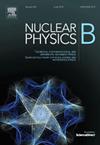The Hubble tension: Relativistic dark matter production from long-lived particles
IF 2.5
3区 物理与天体物理
Q2 PHYSICS, PARTICLES & FIELDS
引用次数: 0
Abstract
The tension between direct measurements of the Hubble constant and those stemming from Cosmic Microwave Background probes has triggered a multitude of studies. The connection between cosmology and particle physics has shown to be a valuable approach to addressing the Hubble tension. In particular, increasing the number of relativistic degrees of freedom in the early universe helps alleviate the problem. In this work, we write down effective field theory describing relativistic dark matter production in association with neutrinos leading to a larger . We derive limits on the effective energy scale that governs this relativistic production of dark matter as a function of the dark matter mass for fermion, vector, and scalar dark matter fields. In particular, scalar dark matter particles are more effective in increasing the effective number of relativistic species. Also, if they have GeV scale masses, then the relativistic production of dark matter should be governed by Planck scale effective operators in order to alleviate the Hubble tension.
哈勃张力:由长寿粒子产生的相对论性暗物质
哈勃常数的直接测量和宇宙微波背景探测器的测量之间的紧张关系引发了大量的研究。宇宙学和粒子物理学之间的联系已被证明是解决哈勃张力的一个有价值的方法。特别是,增加早期宇宙中相对论性自由度的数量有助于缓解这个问题。在这项工作中,我们写下了描述相对论性暗物质产生与导致更大H0的中微子相关的有效场论。我们推导出控制暗物质相对论产生的有效能量尺度的极限,作为暗物质质量对费米子、矢量和标量暗物质场的函数。特别是,标量暗物质粒子在增加相对论性物质的有效数量方面更有效。此外,如果它们具有GeV尺度质量,那么暗物质的相对论性产生应该由普朗克尺度有效算子控制,以减轻哈勃张力。
本文章由计算机程序翻译,如有差异,请以英文原文为准。
求助全文
约1分钟内获得全文
求助全文
来源期刊

Nuclear Physics B
物理-物理:粒子与场物理
CiteScore
5.50
自引率
7.10%
发文量
302
审稿时长
1 months
期刊介绍:
Nuclear Physics B focuses on the domain of high energy physics, quantum field theory, statistical systems, and mathematical physics, and includes four main sections: high energy physics - phenomenology, high energy physics - theory, high energy physics - experiment, and quantum field theory, statistical systems, and mathematical physics. The emphasis is on original research papers (Frontiers Articles or Full Length Articles), but Review Articles are also welcome.
 求助内容:
求助内容: 应助结果提醒方式:
应助结果提醒方式:


